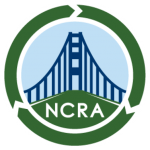 REQUEST TO NOT SUPPORT THE BOONE/STEIN O-MRF/MxWP LAWSUIT
REQUEST TO NOT SUPPORT THE BOONE/STEIN O-MRF/MxWP LAWSUIT
By David Krueger, NCRA President, 6/14/19
The views expressed in this article are solely Mr. Krueger’s and do not represent a formal NCRA position. Mr. Krueger has over 25 years of experience in the recycling industry.
Waste Management of Alameda County (WMAC) is currently constructing a mixed waste processing facility and an indoor aerobic composting facility at the Davis St. Transfer Station in San Leandro. WMAC’s franchise agreement with the City of Oakland requires them to process all mixed waste collected from multi-family dwellings in the City. Oakland also requires all multi-family dwellings to provide source separated recycling and organics services to their tenants. Multi-family dwellings in Oakland are not allowed to “opt out” of having green cart organics service. Oakland participates in Alameda County’s Mandatory Recycling Ordinance.
The new mixed waste processing facility (Organic Materials Recovery Facility, or “O-MRF”) is designed to recover compostable and recyclable materials from Oakland’s garbage that were not recovered through source separation. Oakland residents and businesses will still source separate their discards into three streams (recycle, compost, garbage) and the contents of the garbage containers will be sorted at the O-MRF to recover any organics and recyclables that were improperly placed in the garbage by the generators.
The indoor aerobic composting facility is designed to compost source separated organics from commercial businesses and multi-family dwellings in Oakland and other WMAC cities, as well as organic materials recovered from Oakland’s garbage at the O-MRF. Organics from Oakland’s single-family homes (which consist primarily of yard trimmings) will continue to be transferred through Davis St. to WMAC’s outdoor aerated static pile composting facility at the Altamont Landfill outside of Livermore.
In another article, Arthur Boone encourages NCRA members and the NCRA Board to support he and Toni Stein’s lawsuit against the Alameda County Waste Management Authority (Stopwaste) and WMAC which attempts to require a new EIR for the O-MRF project and, presumably to ultimately stop the construction of the O-MRF and adjacent indoor aerobic composting facility. I respectfully disagree. Mr. Boone lists ten concerns about the facility. I will attempt to address some of his concerns and to explain why I do not support the lawsuit.
- Participation Impacts Issue / Source Separation. Note that the purpose of the O-MRF is to supplement source separation, not to replace it. It is designed to be a “safety net” to catch good stuff that falls through the source separation system and keep it from landing in the landfill. That is how will be used per Oakland’s franchise agreement, and that is how WMAC has marketed the facility to other local jurisdictions. The mixed waste processing will be in addition to three stream source separation by all sectors (single-family, multi-family, commercial) not instead of source separation. Mr. Boone raises a valid concern that some customers may have less incentive to source separate if they know that their garbage will be sorted after collection. However, this participation impact will be dependent upon how the City of Oakland and WMAC educate their customers about the facility and source separation, the financial incentives for source separation in Oakland’s rate structure, and how effectively Stopwaste enforces the mandatory recycling ordinance. If done properly, there should be a minimal impact on source separation. As an example, the Sunnyvale SMaRT station has operated a mixed waste processing facility for over a decade. The cities which use the SMaRT Station (Sunnyvale, Mt. View, Palo Alto) have exemplary source separation programs.
- Waste Diversion. While source separation is the best diversion method, anyone involved in the recycling industry knows that we are not yet to the point where everyone source separates perfectly. There is still way too much “good stuff” going into the garbage. The O-MRF is an attempt to capture that good stuff so that it is not landfilled. I think that is commendable. It is analogous to the standard operating procedure for recycling and composting at festivals and public events: Source separation stations are provided to the public, but a team of event recyclers still has to sort through the “source separated” material after collection to correct errors by the public. This is a low-tech version of the O-MRF and preferable to landfilling the improperly source separated materials. While we must always strive for the top of the discards management hierarchy, we should employ all the other levels of the hierarchy as well. Waste prevention is better than recycling, but we should still recycle what isn’t prevented. Source separation is better than mixed waste processing, but we should still process mixed waste to recover what wasn’t source separated. The alternative is sending more material to the landfill. The end result of any lawsuit which prevents the O-MRF from operating will be more material being sent to landfill.
- SB 1383 Compliance. The current draft of the SB 1383 regulations requires all generators to separate their discards into three streams. Oakland will require all generators to separate their discards into three streams, therefore Oakland will be in compliance with SB 1383. The draft SB 1383 regulations also allow jurisdictions to comply by using mixed waste processing instead of source separation (a “one-bin” “Dirty MRF” system), provided that the mixed waste processing facility meets a very high rate of recovery. However, Oakland’s system will use mixed waste processing in addition to source separation, so the O-MRF will not have to meet the stringent recovery requirement. Oakland will be in compliance by virtue of implementing three-stream collection. The additional recovery from sending the garbage stream to the O-MRF will be above and beyond SB 1383 compliance.
- Site GHG Issue / Aerobic vs. Anaerobic. Boone inaccurately states that the Davis St. composting facility adjacent to the O-MRF, which will compost organics from the O-MRF, will be an anaerobic digester. That is not the case. It will be an aerobic system which uses forced air and mechanical turning to provide oxygen to the materials during composting. It is not designed to create methane. The aerobic composting facility will be completely enclosed a building. Air from inside the building will be treated in a biofilter before being released outside. During the first stage of composting the material will be enclosed in rotating drums in addition to being indoors, further mitigating odors and emissions. Such a facility should produce fewer GHG emissions than the standard outdoor composting facility. The permit for Davis St. provides for three facilities: The O-MRF, the indoor aerobic composting facility, and an anaerobic digester. The O-MRF and the indoor aerobic composting facility are currently under construction and nearly complete. The anaerobic digester is permitted but is not under construction. It may never be constructed. It is not required by WMAC’s franchise agreement with Oakland. It was permitted to provide WMAC with future options for organics recovery.
- Impact on Stopwaste. Stopwaste and NCRA share the same mission. Stopwaste is an innovative, effective Zero Waste organization. Most Stopwaste employees are NCRA members. I don’t believe that NCRA should support a lawsuit against Stopwaste except in very extreme circumstances. I don’t believe that this situation qualifies. Stopwaste’s role in approving the O-MRF was very minor. Stopwaste does not directly permit the O-MRF. Other agencies directly issued permits related to the O-MRF, but they are not being sued. This lawsuit has cost Stopwaste staff time and money which could have been better used implementing Zero Waste programs.
- Impact on WMAC. Some of the things said above about Stopwaste also apply to WMAC and specifically to the Davis St. Transfer station, which provides valuable recycling and Zero Waste education services to the region. NCRA famously sued WMAC over expansion of the Altamont Landfill, and is rightfully proud of the results. However, the O-MRF project is not a landfill expansion. It is the opposite. It is a recycling and composting facility designed specifically to divert discards away from the landfill. Northern California needs more composting capacity – especially for organics from commercial businesses and multi-family dwellings – and the indoor aerobic composting facility being constructed adjacent to the O-MRF will help to provide some of that capacity. Suing WMAC over this project sends Waste Management the wrong message. It is punishing them for doing the right thing. WMAC staff literally spent decades convincing Waste Management corporate headquarters to invest millions of dollars at Davis St. to increase sorting and composting capacity to meet the local demand for waste diversion. Waste Management could have invested that capital in a landfill elsewhere, but they chose to invest in diversion in Northern California. I think that type of investment should be encouraged, not discouraged.
- Why Single Out This Facility for Opposition? As previously noted, the Sunnyvale SMaRT Station has been processing mixed waste for over a decade. It also sends organics recovered from mixed waste to the Z-Best composting facility in Gilroy. There are other established mixed waste processing facilities in the Bay Area, and more in the pilot or permitting stages. To me, it seems that the O-MRF project – and WMAC, Stopwaste, and the City of Oakland – are being unfairly targeted by this lawsuit. Why stridently oppose this mixed waste processing facility and not others?
I believe that NCRA should support the development of more recycling and composting facilities in Northern California and be skeptical of the NIMBY movements that oppose them. I believe that NCRA should support good faith efforts to achieve Zero Waste, and should encourage experimentation and innovation by different cities and business who are working towards our shared goal. There is more than one road to Zero Waste.
# # #
